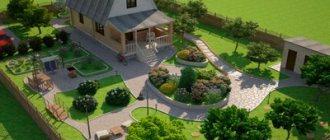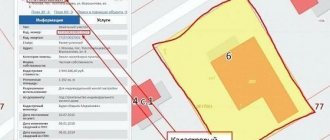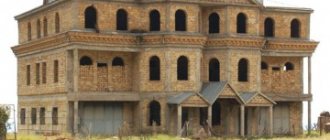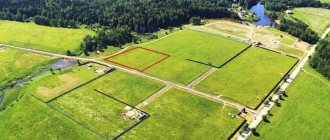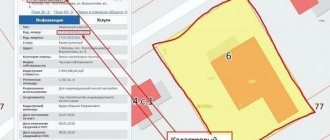We answer a question that worries land owners.
Petrov A.V. owns a plot of land on which a residential building (house) has already been erected, but he wanted to expand and build a cottage, and use the existing real estate as a place of temporary residence.
Another example is when the same Petrov decided to build a second house on the same plot, since there was not enough space in the first one for his family and parents to live.
There are many situations from practice when citizens wonder whether it is possible to build two houses on a plot. It happens when unauthorized buildings are erected that need to be legalized. In any case, it will not be possible to hide a residential property from the registration authorities, so we advise you to use only legal construction methods.
There is no direct ban on the construction of two houses on the same land
Looking into the legislation (Town Planning and Land Codes of the Russian Federation), we will not find any indication that more than one house cannot be built on one plot of land for the purposes of individual housing construction, SNT or private household plots.
However, at the level of regions, villages and districts, local authorities can establish specific rules for the use of land and construction. In short, such rules are called land use and development rules.
According to the PZZ, the maximum and minimum parameters of the land, the permissible percentage of plot (building density) for the construction of real estate, and the standards for setbacks from the boundaries of the site are established. At the local level, restrictions may be established regarding the permissibility of building two houses on one plot of land.
For example, the Leninsky Moscow District of the Moscow Region set the minimum plot size at 400 sq.m., and the urban settlement of Rodniki of the Ramensky Municipal District of the Moscow Region at 600 sq.m. Common to both regions is the maximum percentage of construction, which is 40%, and the minimum setback from the boundaries of the site is 3 m.
Note that the maximum building percentage (density) is calculated as the size of the house along the external walls relative to the land plot. More often the size varies from 20% to 100%.
For example, Ivanov owns a plot of 10 acres, where a house measuring 5 by 6 m was built, which is a house area of 30 sq.m. or 0.3 acres, and the percentage of development on the land is 5. If the property has from 6 to 12 acres, you should focus on 40% for the development of the site.
Two residential buildings on one site: where to start construction
- Contact the local administration and clarify the PZZ, which indicates a ban or permission to build a second house, the permitted location on the site and parameters for construction. The PZZ can also be found on the official websites of the administration of a particular district, for example, type into the search bar of your browser “approved master plans of the PZZ on the official website of the Saratov district administration (replace the region with your own), where the necessary information will open.
- Calculate the percentage of already constructed residential property, since if the permissible percentage is exceeded, the construction of a second house will be refused.
- According to Art. 51.1 of the Town Planning Code of the Russian Federation (GrK RF), send a notice of the start of work to the town planning committee through the MFC, the State Services portal or by mail. The notice contains information about the developer and the site, characteristics of the house and a site plan with two houses, which schematically depicts the planned second residential property. The plan is drawn up by the cadastral engineer of the design organization.
- Having received a positive answer, follow the rules (Grk of the Russian Federation) on the construction of residential buildings. For example, according to paragraph 39 of Art. 1, objects for individual housing construction should not exceed a height of 20 m and occupy more than three floors. If similar and other conditions (fire safety requirements, sanitary standards) are not met, the structure will be recognized as an unauthorized construction.
- Maintain a distance between houses on the site of six or more meters based on building materials, and at least three meters from the house to the boundaries of the land.
- Having completed construction, draw up a notice of completion of work and send it to local authorities no later than a month after the construction of the second residential building on the site. The form for drawing up the necessary notifications can be found in the Appendices to the Order of the Ministry of Construction and Housing and Communal Services of the Russian Federation dated September 19, 2018 No. 591/pr “On approval of notification forms required for the construction or reconstruction of a real estate property, an individual construction project or a garden house.”
- Assign an address to a new residential property (house) before state registration in Rosreestr. The building will have a number similar to the existing object, but with a letter (Moskovskaya St., 21 lit. A), a fraction (Moskovskaya St., 21/1) or a postscript (Moskovskaya St., 21, building 1). Assignment is carried out by local authorities (city department of architecture and urban planning in the local administration, property department) after submitting the appropriate application.
- Send documents for registration of a new residential property to Rosreestr.
✨ Brief summary
To sum it up:
- The construction of a second residential building on a plot of land is possible - the law does not limit the number of houses.
- When making a decision on construction, you need to get acquainted with the Development and Land Use Rules (DZR) and the Land Boundary Plan (PGZU) , which are adopted by municipalities. Each such formation has its own rules. Documents can be found on official websites in the public domain.
- In order to obtain an official construction permit , it is enough to submit a notification of the start of construction to the administrative authorities, providing for all the standards provided for by the PZZ and PGZU.
- If you plan to sell the house in the future, it is better to immediately divide the plot into two : construction will be carried out on a separately registered plot of land, and it will be easier to sell such a house.
Two residential buildings on an individual housing construction plot
The legislation establishes the rule for the construction of one residential building. The construction of other buildings is possible when they are not intended for housing (baths, sheds, garages) and are considered auxiliary facilities.
Please note that there is no direct indication for the construction of only one residential property on land for individual housing construction.
If two houses on an individual housing construction plot have already been built, the land is divided into two separate plots, on each of which there will be a residential building.
When dividing, they turn to a cadastral engineer, who, through land surveying, will establish the boundaries of the newly formed plots of land. Each of them is registered in Rosreestr, and the previous (single) one is removed from the cadastral register.
When dividing a plot for two houses, you must follow the rules regarding the intended purpose of the new plots, type of use, area, and the absence of restrictions on construction.
The owner becomes a taxpayer for two plots of land and pays membership fees when the land is divided in order to build houses on the SNT plot. Their size is set in proportion to the number of plots owned by the owner.
If you don’t want to “mess around” with the division, on lands for individual housing construction, you can build two houses on one plot without land surveying, if you assign the second real estate the status of a guest house or an auxiliary building, for example, a bathhouse with living rooms.
But it is worth remembering that such an object is not assigned an address and it cannot be sold without the main house.
It’s easier to register two residential buildings on the site and sleep peacefully.
To obtain a building permit, a request is submitted to the local administration, accompanied by an extract from the Unified State Register of Real Estate on the ownership of the site, a town planning plan, and a land diagram indicating the location for the planned second home.
Step-by-step instructions: registering a plot of land for a two-apartment low-rise building
If the right to a residential premises is registered, but the land plot underneath it is not, the Rosreestr Office for the Perm Territory recommends doing this for several reasons:
- a plot with a legalized structure can be privatized (provided free of charge), or must be purchased by the owners, or a lease must be issued for it (Clause 3, Article 28 of the Federal Law of December 21, 2001 No. 178‑FZ “On the privatization of state and municipal property” );
- the use of a land plot without duly executed land title documents entails administrative liability in accordance with Art. 7.1 Code of Administrative Offenses of the Russian Federation;
- By acquiring land ownership, the owner of the land plot can use such land in any way not prohibited by law, including as collateral for obtaining a loan from a banking organization. A plot of land registered as your own can always be resold, donated, or left as an inheritance.
There are two ways to register ownership of a plot of land for a two-apartment (or more) low-rise building.
- Register the land plot under the apartment building as common shared ownership. In this case, a two-apartment building must be recognized as an apartment building.
- Register a plot of land under part of a residential building in a blocked building. In this case, the land plot under the corresponding block is subject to cadastral registration, and not a single plot under a house, as under an apartment building.
Registration of a land plot under an apartment building into common shared ownership. If a two-apartment building is recognized as an apartment building, registration of the land is carried out into common shared ownership. It must be borne in mind that apartments can only be located in an apartment building, which, in turn, can be located on a plot of land that provides for the possibility of placing and operating an apartment building. The main qualifying feature of an apartment is the possibility of direct access from the apartment to common areas. If there is no direct access from the residential premises in a house to the common areas in such a house, but there are exits directly to the land plot on which the house is located, then such residential premises are not apartments, and the house is not an apartment building. In other words, if an apartment has access to common areas (attics, basements, etc.), then such a house can be recognized as an apartment building. The procedure for registering a land plot for an apartment building consists of the following steps. Step 1: Determine whether the plot is registered in the cadastral register. A land plot formed before the entry into force of the Housing Code of the Russian Federation (before March 1, 2005) and in respect of which state cadastral registration was carried out passes free of charge into the common shared ownership of the owners of premises in an apartment building. Step 2: Hold a general meeting of all apartment owners. If the land plot is not formed before March 1, 2005, then in this case it is necessary to hold a general meeting of all apartment owners, make a joint decision on the formation of the land plot, and also select an authorized person. You can obtain information about the fact of the formation of a plot under an apartment building and its cadastral registration on the public cadastral map on the Rosreestr website or request information from the cadastral chamber or the MFC. The decision of the general meeting of owners of premises in an apartment building is documented in a protocol (for the form of the protocol, see Order of the Ministry of Construction and Housing and Communal Services of the Russian Federation dated July 31, 2014 No. 411/pr). Step 3: The representative of the owners elected at the meeting must submit an application for the formation of a land plot to the administration of the municipality on whose territory the land plot is located. This application will be the basis for cadastral work and state registration of the land plot. At this stage, the availability of a land surveying project for the block on which the land plot is located is checked. If available, a decision (order) is issued to approve the boundaries of the site on the cadastral map of the territory. If the land plot is located on an undemarcated territory, then the block is included in the corresponding land survey plan. Cadastral work is carried out on the basis of an order approving the boundaries of a land plot. Residents also have the right to contact a cadastral engineer to carry out cadastral work to determine (clarify) the location of the boundaries of the land plot. At this stage, a boundary plan is drawn up. Step 4: Submit an application to the cadastral chamber or to the MFC for registration of the land plot with cadastral registration. In addition to the application, it is necessary to provide the minutes of the general meeting of premises owners and the boundary plan of the land plot. The cadastral registration service is free and takes 10 working days. If the cadastral registration authority makes a positive decision, the applicant is issued a cadastral passport of the land plot. Step 5: Submit documents for state registration of rights to a land plot at the offices of the cadastral chamber or MFC. You can also submit documents electronically via the Internet, including the Unified Portal of State and Municipal Services. The following documents must be provided:
- Application for state registration of the right to common shared ownership.
- Technical passport of the house.
- A document that confirms the authority of the owner's representative.
- Document confirming payment of state duty.
- Documents on the formation by a state authority or local government of the land plot on which the apartment building is located, if the land plot was formed after 03/01/2005.
- A technical accounting document for an apartment building containing information about the composition of the common property of the apartment building.
- Decision (minutes) of the general meeting of owners, other agreement of participants in common shared ownership of common property in an apartment building (information about the owners of all specific premises (residential and non-residential) in an apartment building is indicated, as well as the size of shares in the right to common property determined by the meeting or agreement in the apartment building of each owner (in the form of a proper simple fraction).
- Title documents confirming that the owners have rights to the premises.
Please note that land plots that are part of the common property of an apartment building are not recognized as a subject to land tax from January 1, 2015. Registration of a land plot under a part of a residential building in a block-building building A block-building residential building is a residential building that is not intended to be divided into apartments and has one or more common walls with neighboring residential buildings (the number of floors is no more than 3, with a total number of combined buildings not more than 10, and each of which is intended for single-family residence, has a common wall (common walls) without openings with the neighboring block or neighboring blocks, is located on a separate plot of land and has access to a common area.If the house is located on land for individual housing construction, it is necessary to comply with the permissible area of the plot for individual development. That is, the size of the land plot under the block must correspond to the dimensions established by the Land Use and Development Rules of the relevant municipality. Step 1: Privatize the plot. First of all, to register the land plot as a property you will need availability of a title document for the land plot. Such a document can be: a development agreement, a court decision, a purchase and sale agreement, an old-style certificate of ownership, an extract from the house register. In the absence of land allotment documents, the owner of the house can either privatize the land plot for free or buy it from the administration. It is important to note that free privatization of a land plot can be carried out if citizens are the owners of buildings, houses built before October 29, 2001, which are located on this land plot. Either after October 29, 2001, i.e. before the day of introduction of the Land Code of the Russian Federation, provided that the ownership of a residential building passed to the citizen by inheritance and the testator's right of ownership of the residential building arose before the day of entry into force of the Land Code of the Russian Federation. Also, if the leased land plots for building your own house or running a subsidiary farm were leased until October 29, 2001, i.e. before the Land Code of the Russian Federation comes into force. In other cases, the “unowned” share of the land plot will have to be purchased from the local administration. It is also necessary to take into account that the municipal administration may not provide the site. In this case, the dispute will have to be resolved in court. Please note that land is not subject to transfer into private ownership if the site belongs to the category of lands withdrawn from circulation or lands limited in circulation, for example, nature reserves. There is a ban on privatization if the site is reserved for state or municipal needs. To contact the administration of the municipality on whose territory the land plot is located, it is necessary to prepare a package of documents: an application for the provision of ownership of the land plot, documents confirming the right to use the land plot, for example, a lease agreement or a decision of local authorities on the allocation of land for use, technical passport for a residential building. Within 2 weeks, a decision will be made on the transfer of the plot (a resolution on the provision of ownership of the land plot). If the gratuitous transfer is refused, the administration will offer to purchase the land plot. Step 2: Register the land plot with cadastral registration. To do this, it will be necessary to carry out land surveying (carried out by cadastral engineers; a register of certified cadastral engineers is available in the cadastral chamber, on the Rosreestr website). Based on the survey results, a land survey plan is issued. The boundary plan is the basis according to which the cadastral chamber registers this plot and assigns it a unique cadastral number. Step 3: Submit documents for state registration of rights to a land plot to the cadastral chamber or to the MFC:
- an application requesting a certificate of ownership of a land plot;
- a document evidencing ownership of a land plot (a decree granting ownership of a land plot, a development agreement, a court decision, a purchase and sale agreement, an old-style certificate of ownership);
- technical passport of the household;
- cadastral passport;
- receipt of payment of state duty.
First Perm legal portal
Two separate houses on a plot: how to sell and buy
“Practice shows that despite the absence of a ban on the construction of two houses within the same plot, Rosreestr does not register ownership of a second residential property if the land is not divided into separate plots. Often houses are recognized as unauthorized constructions and demolished,” this statement was received from a real estate expert.
There are not as many people wishing to buy two houses on one plot as the owners would like. In such situations, the land is either divided or each house is sold separately. When purchasing one of two houses, the buyer must understand that he will only own 1/2 interest in the land title.
Not all buyers agree with such rules, which leads to difficulties in selling two houses on the same plot.
Alternative solution
You can also get around the ban by building a small country house and registering it as an outbuilding. The benefit here also lies in the fact that sometimes there are difficulties when registering a second house as a residential one. For example, in the village there are “not enough” communications for it, and without them the house will not be recognized as residential. However, such a house will still have to be registered as real estate, since it will be a permanent building. But if you build a non-permanent house, you can even do without obtaining a building permit.
Is it possible to build a second house
Technically, two houses on one plot can be built, but will it be possible to register ownership of the second building? Let's figure out what the current legislation says.
The classifier of types of permitted use of land plots (Order of the Ministry of Economic Development of the Russian Federation No. 540 dated September 1, 2014) assumes that a house for one family can be located on a plot intended for individual housing construction (IHC). It must meet the following requirements:
- no more than three floors;
- no higher than 20 m;
- consist of living rooms and auxiliary premises to satisfy household and other needs;
- not intended to be divided into independent objects.
It is allowed to erect auxiliary buildings, such as a garage, barn, bathhouse, etc.
On plots intended for personal farming (LPH), it is allowed to build a residential building and place auxiliary buildings. A residential building must comply with the characteristics provided for individual housing construction projects.
In areas for gardening and dacha needs (DNT and SNT), it is allowed to relax, grow crops and place garden and residential buildings for one’s own needs, as well as outbuildings. It is allowed to build a residential building described in the individual housing construction category of the Classifier.
Current regulations governing the use of land plots do not contain provisions on the number of houses on one property. If we rely on judicial practice, then a second house on a summer cottage or other plot raises serious disputes.
The ruling of the Supreme Court of the Russian Federation dated October 16, 2021 No. 5-KG18-206 in the case of recognizing the right of ownership of an unauthorized construction states that the construction of a single residential building is permitted on a plot for private household plots. However, the Judicial Collegium for Civil Cases of the Armed Forces of the Russian Federation has a different opinion and argues that for the construction of houses and outbuildings on a site, it is necessary to be guided by the stipulated sanitary, urban planning and other regulations and standards.
In accordance with the provisions of the Town Planning Code of the Russian Federation (GrK RF), development rules provide for certain parameters that must be observed when constructing buildings and structures. In clause 4, part 1, art. 38 of the Civil Code of the Russian Federation states that the rules establish the development coefficient. It represents the ratio of the total area of the construction site to the area of the entire site. It is this indicator that is decisive in determining whether a new house can be built next to the old one or not.
What is a real partition?
Real division (allocation of shares) is the transfer of parts of the home ownership into the ownership of each participant in the common shared property in proportion to his share.
Division entails the termination of common property for all its participants. The allocation of a share of a house is characterized by the fact that one or more owners leave, while for others the relations of common ownership are preserved.
The division of the house begins with determining the size of the shares and the people who have rights to the share. In case of divorce, the owners of the shares will be the spouses, and in case of inheritance, accordingly, the heirs.
The real division of the house and land is permissible and possible only when legal and technical possibilities exist. Real estate objects, including a residential building and a land plot, can be classified as both divisible and indivisible things.
How to divide a house? And what can be shared and what cannot?
The actual possibility of dividing a house and land does not always coincide with the legal possibilities. The divisibility of a property, from a legal point of view, has an independent meaning and does not necessarily coincide with the real possibility of dividing walls and rooms.
All existing real estate objects are recognized as physically divisible, but they are legally divisible only if it is possible to divide them into parts in such a way that each part maintains homogeneity, that is, remains “residential” for its intended purpose and so that its use does not violate the rights of others copyright holders and users.
In other words, when dividing a house, each owner must have his own entrance, kitchen, bathroom, etc.
For the correct division of real estate, the law introduced the concept of Signs of residential premises:
- appointment;
- suitability for habitation;
- isolation;
- belonging to the category of immovable objects.
Of course, the last of the signs is the main one, however, the absence of any of the listed signs gives grounds to consider the premises non-residential.
It is unacceptable to divide a house as a result of which an independent part is formed that is not intended for living (for example, a built-in garage or just a kitchen).
How to register a new building
Since current legislation does not prohibit the construction of two or more houses on one plot of land, a new building can be registered in the prescribed manner. The stages of the procedure depend on the specifics of the case.
For example, a land plot may be jointly owned by two persons. If the property cannot be physically divided, the owners have the right to enter into a written agreement on the procedure for using the site. In the text of the agreement, the parties agree on the construction of houses for each of them.
Next, permission is obtained for the construction and construction of houses, taking into account the established rules. After the house is completed, it is necessary to register it with the cadastral register and make an entry, as well as change the existing data about the site in Rosreestr.
To do this, owners contact Rosreestr or MFC with a package of documents, which includes:
- construction permit or court decision;
- technical plans for the house;
- two originals of the agreement on the procedure for using the land;
- receipt of payment of state duty in the amount of 350 rubles.
If the situation is different and there is only one owner, the same package of documents is submitted with the exception of the agreement on the procedure for using the land.
A Rosreestr or MFC specialist accepts documents and issues a receipt. It specifies the date on which you need to come for the originals and pick up the current extract from the Unified State Register. It serves as confirmation of the registration of ownership of the new home.
Is it possible to build a new house on the site of an old one?
A common situation is when the owner demolishes an old house and builds a new one in its place. At the same time, he does not re-register any documents for the object. However, it is necessary to act according to the law:
- Applying to the municipality to obtain a building permit.
- Drawing up an inspection report to remove an old house from cadastral registration. The act is issued by a cadastral engineer. This document is the basis for deregistering an object.
- Applying to Rosreestr or MFC with an application to deregister the old house. An inspection report is attached to the application.
- Ordering a technical plan for a new home. The document is prepared by a cadastral engineer.
- Submitting a notice of completion to the municipality. A technical plan must be attached to it.
If no violations are found in the new home, a compliance notice will be issued. Next, the object is registered in the cadastral register.
If the administration refuses, you can challenge this decision in court.
For this you will need the following documents:
- written refusal received from the municipality;
- extract from the Unified State Register of Land Registers for the land plot;
- technical plan for a new house;
- coordination with authorized bodies (if necessary);
- expert opinions from utility services.
In some cases, a construction expert may be required. If there are no violations, the expert's opinion will help persuade the court to make a decision in favor of the applicant.
If the land is leased
If it is planned that there will be two houses on the rented plot, then the registration procedure is similar to that described above. When it is assumed that the old building is to be demolished, the new building must be designed according to the following scheme:
- Applying to the BTI with a statement in the established form with a request to recognize the old building as non-residential (for example, to make it a summer kitchen), and to assign the new one the status of residential real estate.
- Issue a technical passport for a new building. The specialist is located at the BTI.
- Make changes to the Unified State Register of Real Estate – register a new house and change information about the old building.
- Register ownership of a new home.
How many houses are allowed to be built on a rental plot? From a technical point of view, it is necessary to look at the established parameters for building density and sanitary standards.

